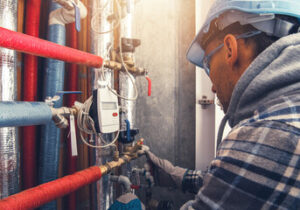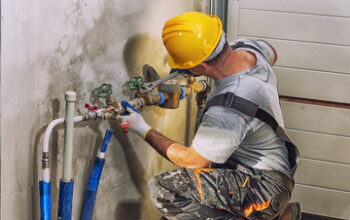Commercial plumbing is used in larger spaces like high-rise offices, shopping centers, hospitals, and warehouses. Larger buildings have more occupants and visitors, so there’s a higher risk of blockages or clogs.
Small leaks and clogs might go unnoticed in a home but could have serious consequences in a commercial space. Choosing Plumber Clearwater FL for your business is important.

A commercial plumbing project can take on a much larger scope than a residential one. This is due to the fact that commercial buildings usually have far more sinks, toilets, water heaters and outlets than homes. As such, they need bigger pipes and fixtures that can withstand a greater amount of daily usage.
Another factor that contributes to the size and complexity of commercial plumbing is the fact that many of these systems serve a variety of functions beyond simple water and sewer. For example, a restaurant might require multiple soda machines or icemakers to keep up with demand. In addition, a building that houses offices or apartments may need to have fire sprinklers installed to comply with building codes. These types of systems often require their own unique pipes, fixtures and safety measures that are outside the realm of expertise for most residential plumbers.
The size of commercial pipes also makes them more prone to damage and clogs than residential ones. This is because a single commercial space might have hundreds of people using the same toilets, sinks and drinking fountains on a regular basis. This creates a higher stress on the system and can lead to more frequent problems, especially if the building is not adequately maintained on a regular basis.
This is why it is crucial for commercial spaces to have a detailed plumbing scope that clearly defines the work and materials required. This way, the right materials can be chosen and potential complications or unforeseen issues are assessed in advance. A comprehensive plumbing scope also helps ensure that the finished product is as functional and durable as possible, reducing future maintenance needs. In addition, it allows the project manager to determine how long the job should take and set appropriate expectations with clients. This helps reduce misunderstandings and miscommunication that can lead to delays and extra costs down the road.
Many commercial plumbing projects involve work on multiple buildings. These buildings may be office complexes, shopping malls, apartment buildings, or even skyscrapers. Each building will need its own piping network to get clean water to each fixture and remove waste from the fixtures. This requires a lot of coordination between plumbers and architects to ensure each part of the system is installed properly and will function as intended.
Commercial plumbing projects also often require a more extensive piping network than residential ones. This is because these pipes are used by more people on a daily basis, so they experience more wear and tear. It is important that these pipes have proper sizing to ensure they will not break or become clogged easily.
Another difference between commercial and residential plumbing is the amount of drainage required. Because these pipes are used by more people, they need to be able to dispose of excess water faster than residential systems. This means that these piping networks need to be bigger and have more outlets to allow for this increased flow.
The piping network in a commercial setting also needs to be hidden as much as possible to prevent tampering and other issues. This is especially true in multi-occupancy buildings where one tenant’s carelessness could affect the water quality for all tenants. To help combat this, these piping networks are often concealed under the floor or in the walls to make it more difficult for tenants to tamper with them.
These piping networks also need to include the sanitary drains. This is because these pipes are responsible for removing fecal matter and human waste from the buildings. These drains also need to be sized correctly so that they can handle the volume of human waste that is produced on a daily basis.
Another issue that can impact the piping network in a commercial setting is the use of chemicals. These chemicals can seep into the piping and cause corrosion that can break down the pipe over time. This is why it is important that these piping networks are made from high-grade materials that will hold up well against the corrosion caused by these harsh chemicals.
Keeping up with commercial plumbing codes and regulations is essential to the health of your building occupants. Whether it is ensuring that your drainage systems are efficient enough to avoid clogs or that you have the right backflow prevention system in place, adhering to these standards can help protect your occupants and prevent costly repairs and safety hazards.
One of the most common commercial plumbing codes is the Uniform Plumbing Code (UPC). Local governing bodies use this model to establish minimum requirements for plumbing systems and components in buildings. It is a comprehensive set of guidelines that covers everything from water supply and distribution to waste disposal and draining.
The UPC requires that all piping within a structure be adequately sized to handle the maximum load expected. In addition, all piping must be free of defects and obstructions. Pipes used for drinking water must not be made from lead. For the most part, this requirement is easily met by choosing a piping material like stainless steel or copper-base alloy. The code also requires that a trap be installed in all piping that conveys waste water or sewage. This prevents sewer gases from entering the water supply.
Another important rule is that a backflow prevention device be in place to ensure that potable water is not being contaminated by nonpotable or vice versa. These devices can include double check valves, pressure vacuum breakers and combination backflow preventers. The rules require that they be certified by a professional organization such as ASSE International.
The sanitary sewer system in a building must be sized to accommodate the maximum discharge from the plumbing fixtures. This means that all toilets, lavatories and tubs must be sized according to their water usage. It is also a good idea to install high-efficiency water heaters, which can save your business money on energy bills.
A properly sized gas system is also important to prevent gas leaks and other accidents. This is particularly true when using natural gas, which can be a fire hazard and a health hazard if it is not properly installed or maintained.
A commercial plumbing system can have more components, larger pipes, and higher water pressures than a residential one. It also uses sophisticated equipment that requires specialized knowledge to handle, which means there are more potential problems that may occur. These factors can make a commercial plumbing project more challenging, and it’s important that they’re done correctly to ensure the safety of everyone who enters the building.
Effective plumbing systems are designed with client needs, building codes, and industry best practices in mind. This includes considering the number of bathrooms and sinks required, the expected occupancy, and if the space is intended for future expansion or modifications. It also means positioning plumbing fixtures in a way that ensures proper performance and allows for the most efficient operation. For example, positioning water supply lines near restrooms reduces the distance the water travels, which can improve water flow and pressure.
Another factor to consider is the type of water usage. For example, water-saving toilets and faucets can reduce water consumption while still maintaining functionality. It’s important to note that if the water volume in a sink or toilet drops significantly, this could be a sign of corroded pipes and should be replaced as soon as possible.
For new construction projects, involving plumbing experts early on can help ensure accurate planning, better coordination with other trades, and streamlined installation. This can also help minimize costly mistakes and repairs down the road.
In addition, implementing innovative technologies during the design phase can increase efficiency and save time and money. For example, leveraging 3D modeling and Building Information Modeling (BIM) software can improve visualization, clash detection, and streamline coordination with other disciplines. It can also allow for the use of prefabricated components, which can be built offsite and seamlessly installed at the construction site.
A plumbing business can grow its customer base by developing a loyalty program that rewards repeat and referral customers. It can also invest in online marketing to attract new customers and expand its social media presence. By creating a professional website, utilizing SEO, creating valuable content, and collecting customer reviews, it can boost its visibility and build trust among potential clients.


